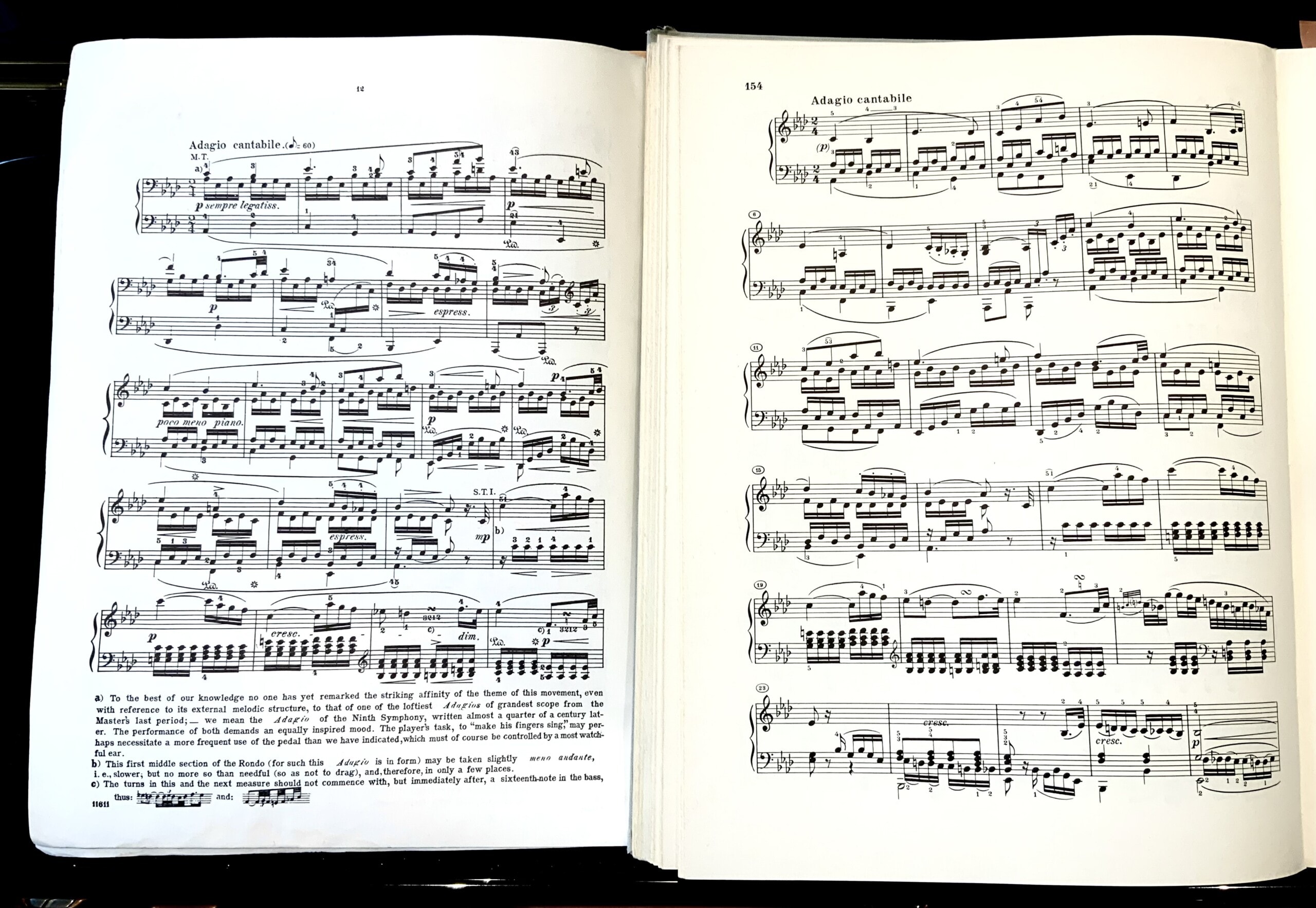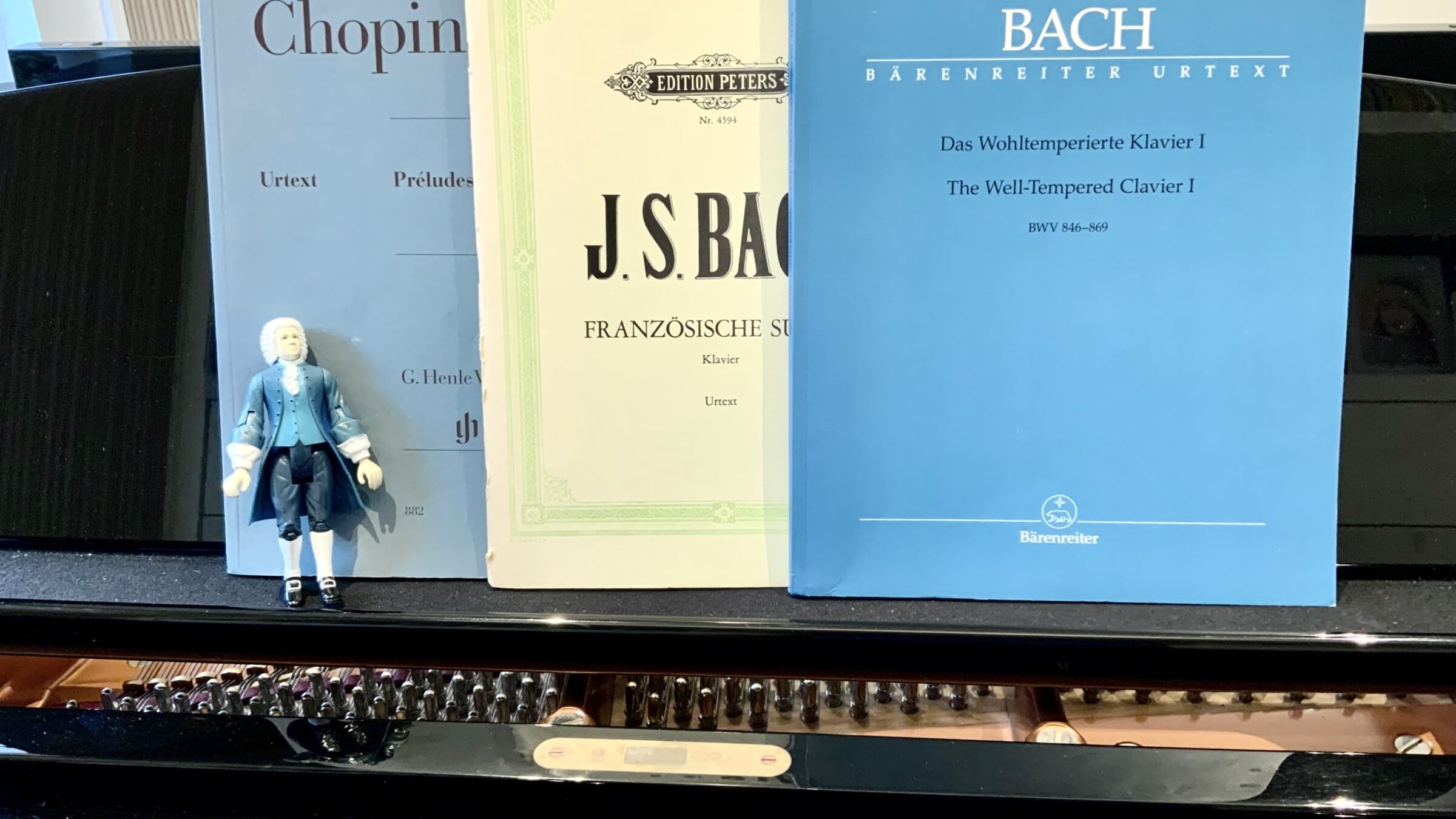My very first Russian score of the Well-Tempered Klavier finally disintegrated beyond salvation, the yellowed pages losing corners, crumbling and separating as the binding glue dried out completely. It was an edition from the 1980s with commentaries and fingerings by someone named Bruno Muggelini. That edition of the WTK was accepted (by the powers that be?) as the standard in the USSR and my teacher used it with all of her students. The score had sentimental value but I have to confess that I’ve been using “Urtext” editions as an adult. And not just for Bach.
The prefix UR roughly means “original” in German and “Urtext” describes an edition where the score is reproduced exactly as the composer wrote it. Here is a photo comparing 2 editions of the famous slow movement from Beethoven’s piano sonata Op. 13 known as the “Pathetique.” On the left is a Schirmer edition “revised and fingered by Hans Von Bülow” and on the right, an Urtext from Henle, a German publisher. In other words, on the left is Von Bülow’s take on Beethoven’s music but Beethoven’s actual score is on the right.

Which score would you prefer to study? There is no doubt that Von Bülow – a famous 19th century pianist and conductor, a student (and son-in-law) of Liszt and generally a big name in music history – is a worthy guide and authority. When we look at his edited version we see a myriad of tiny crescendos, diminuendos and other innuendos which will keep you busy yet (in my humble opinion) trivialize the music into a recipe for sentimentalism. Will an average piano student stop and question this “interpretation” or will they just assume everything here is “written in stone?” In the Urtext there is nothing until measure 24, not even a starting dynamic level. Did Beethoven forget? Unlikely, since he was very exacting and expressive with his intentions, as seen elsewhere in the sonata and in the rest of his scores. The guy was no slouch.
Would Beethoven have wanted you to play this beginning softly, as implied (in parentheses) by the Urtext and directed by Von Bülow? How softly CAN one actually play such a dense texture without losing the cantabile of the long upper notes? And what about Von Bülow’s crescendo in m. 3, followed by another one in m. 4? How good would that actually sound? Maybe Beethoven allowed that a range of dynamics could work, as long as the theme is played as written: an expansive 8-measure phrase, in a beautiful key of A-flat major.
I have no doubt that Shirmer’s intentions in giving Von Bulow some money to “brand” their sheet music were good. Nor do I doubt Von Bülow’s good intentions in editing Beethoven. Although I do wonder if, on another day and after a different lunch, Von Bülow might have used some other markings. Or if a busy celebrity conductor like himself might have delegated this menial task to a capable student? Of course, we will never know. What we do know is that Beethoven’s own intentions are obscured.
So when shopping around for sheet music, please do invest in a good edition. For Baroque and Classical repertoire that means an Urtext edition. Henle, Baerenreiter or Peters are all excellent. They may seem pricey but are well worth it in the long run. Urtexts are also laid out more spaciously and look nicer. For Romantic music and later, if there is no Urtext, see if you can get an edition from the composer’s native country. After 1800, a lot more was specified in manuscripts so editors’ tasks were mostly reduced to musicological babble and fingerings. Ah yes, those fingerings, which also seem to be written in stone and yet are so often assigned by non-performing musicians… buyer beware. There will be a long newsletter about this one day soon. When in doubt, research IMSLP Petrucci for different editions.
There are always countless decisions to make when I get my transcriptions ready for publishing. Many of you have written that you like the spiral binding: easy to keep the music open and it won’t fall apart. I also use premium quality paper and hope that it will hold up better than my old WTK edition. And of course these days PDF files enable us to use an iPad or print ourselves. When it comes to editing, I am always torn: leaving Bach’s original visually unadorned is a must yet many people appreciate some guidance. So in the new – and finally available – Orchestral Suites for piano duet there are very few additional markings in parentheses. My comments can be found on a separate page. After all, music is a subjective art.
Make your own choices and enjoy experimenting!
